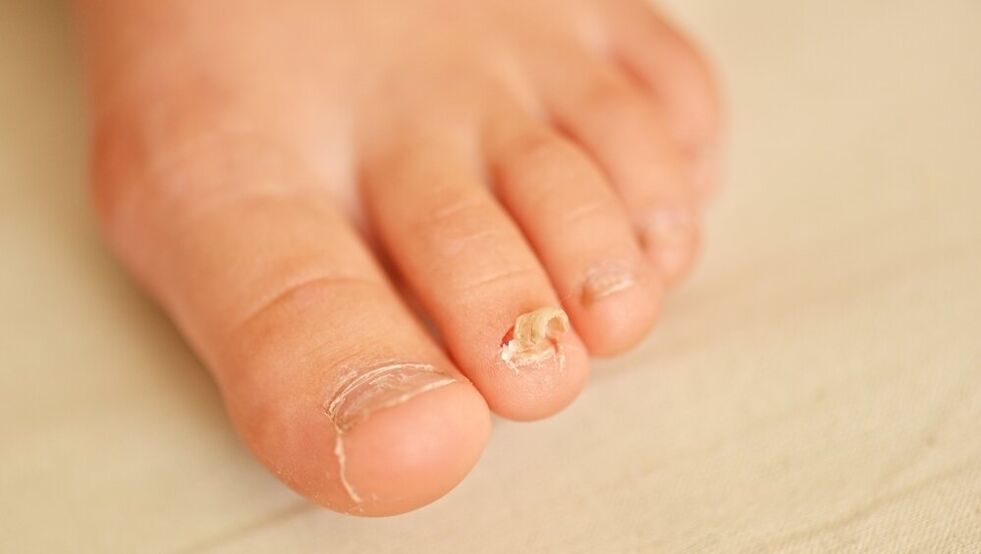An annoying disease like nail fungus (or onychomycosis) is one of the most common worldwide. According to statistics, every tenth inhabitant of our planet suffers from foot fungus! Different species, both sexes and all ages are susceptible to the disease - from preschoolers to the elderly.
Many people believe that foot fungus can only occur in those who neglect personal hygiene, forget to check the condition of the skin of the foot, and so on.

In fact, nail fungus can appear in a clean person because the infection is very easy to "catch" in public places - beach, sauna, swimming pool, gym, etc. Nail fungus is a disease, although not fatal, but very insidious. however, it can have serious consequences such as the destruction and deformation of the nail, which never takes its former form. In addition, onychomycosis is highly contagious, so a person who has found a fungus can easily infect all members of the household.
Toenail fungus: first signs
In the first stage, the pathology is quite difficult to identify, but it is possible if you thoroughly examine the condition of the nails and the skin around them.
The main signs of mushroom identification are:
- thickening of the nail plate;
- the appearance of grooves, streaks and spots on it;
- loss of light and elasticity of the toenails;
- nails cut into the skin of the legs that had not been observed before;
- the skin around the nail plate began to itch and caused the person to feel uncomfortable; sometimes itching begins between the fingers (these symptoms are common in children and adolescents because their skin is much thinner and more sensitive than in adults).
Other signs and symptoms then appear as the fungus develops:
- distortion of the structure of the toenails - they become brittle, scaly, crumbly edges appear;
- color change - instead of the usual healthy transparent white color, the disc gets unnatural shades such as purple, yellow or even black;
- the nail deforms, becomes flat or convex, and tubers form on it.
But peeling nails are symptoms of an advanced stage of the disease. The nail separates from the skin, forming a pocket in which the pathogenic bacteria accumulates and actively multiplies. This often manifests itself after contact with warm water - when you take a shower, take a bath, swim in the pool, take a steam bath. Once the feet are dry, the disc may stick to the skin again.
Sometimes similar symptoms can occur in a person who does not suffer from a fungus. The nail may turn black, come off, and then fall off completely due to mechanical damage. The dying process begins a week or two after you have injured your toes or simply wore tight, mismatched shoes.
Usually, after six months, a new, completely healthy nail plate grows. A trained dermatologist or surgeon can determine if it is a fungus or just the consequences of an injury.
These symptoms are also accompanied by an unpleasant odor created by pathogenic bacteria. A person suffering from nail fungus has an unpleasant odor in socks and shoes, and standard hygiene procedures cannot eliminate this symptom. This situation requires complex treatment, otherwise a person may lose their nail plate.
Treatment of onychomycosis
One is able to recognize the first symptoms of the disease on one's own. But even if you are sure that you have symptoms of nail fungus, you should seek the advice of a qualified doctor, otherwise the treatment may not produce the desired results. The specialist will help you recognize the disease, determine its stage and prescribe the necessary treatment.
First of all, the causes of the disease must be eliminated:
- humid and warm environment. Wear only socks, stockings and shoes made of natural materials. Dry your shoes after each street visit, change your socks, don’t let your feet stay wet for long;
- do not wear other shoes, use personal changing shoes in public places - swimming pool, sauna, beach - which are disinfected with chlorine or alcohol after each use;
- weak immunity. Often this disease occurs in the background of weak immunity, lack of useful nutrients in the body, frequent colds. After consulting your doctor, take a vitamin and mineral complex that strengthens the immune system and helps with treatment accordingly.
Traditional treatment
Topical treatment of onychomycosis in the initial stage consists of the use of antifungal creams and ointments. These foundations are usually sold with a special waterproof patch.
Using a dispenser, the drug is applied to the affected nail plate, fixed with plaster and left for 24 hours. The patch should not be removed during this period.
After one day, remove the patch, lower your feet into a warm soapy solution, and remove dead tissue with a pedicure nail file.
After removing the affected areas of the nail plate on the feet, the product should be applied to the nail bed. The duration of such treatment is until the growth of a healthy plate.
In the first stage of the disease, only when the first symptoms appear, special antifungal varnishes can be used. Apply this varnish once or twice a week throughout the year.
However, if such therapy does not help and the fungus is already at another stage, more effective drugs are needed. In this case, general-purpose antimycotics will be needed. They can also be combined with antifungal varnishes. The process of treatment with systemic drugs is prescribed individually by the physician, depending on the stage of the patient's onychomycosis.
Such funds have a number of limitations - kidney and liver disease, pregnancy, the period of breastfeeding the baby. It must also not be combined with oral contraceptives.
Although nail fungus is a disease that is not dangerous to human life, it can cause allergic reactions, decreased immunity, and the occurrence of various skin conditions in the absence of the necessary therapy. Therefore, the treatment of this disease can not be postponed, consult a specialist immediately.
























